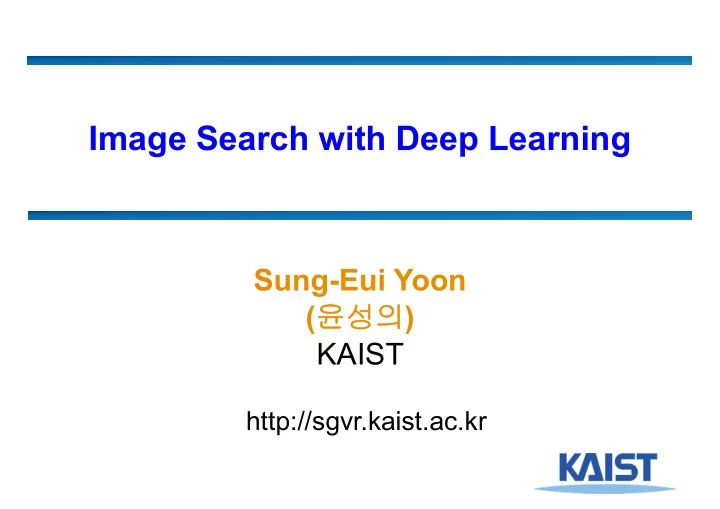

Image Search with Deep Learning Sung-Eui Yoon ( 윤성의 ) KAIST http://sgvr.kaist.ac.kr
Class Objectives are: ● CNN based approaches ● Consider different regions, attention, and local features ● Discuss applications ● At the prior class: ● Discussed unsupervised hashing techniques based on hyperplanes and hyperspheres ● Talked about supervised approach using deep learning 2
PA2 ● Apply binary code embedding and inverted index to PA1 ● k-means or product quantization (PQ) for inverted index ● Spherical hashing or PQ for binary code embedding 3
ImageNet Classification with Deep Convolutional Neural Networks [NIPS 12] ● Rekindled interest on CNNs ● Use a large training images, ImageNet, of 1.2 M labelled images ● Use GPU w/ rectifying non-linearities 4
Tested on ILSVRC-2010 5
Neural Codes for Image Retrieval [ECCV 14] ● Uses top layers of CNNs as high-level global descriptors (Neural Codes) for image search 6
Sum Pooling and Centering Priors ● Inspired by many prior aggregated features (e.g., BoW) ● Use convolution layers as local features ● Aggregation ● Simply sums those local features or ● Considers centering priors w/ varying weights 7 Ack.: Aggregating Deep Convolutional Features for Image Retrieval
Localization: Faster R-CNN ● Insert a Region Proposal Network (RPN) after the last convolutional layer ● RPN trained to produce region proposals directly ● No need for external region proposals! ● Use RoI pooling and an upstream classifier and bbox Ren et al, “ Faster R-CNN: Towards Real-Time Object Detection with Region Proposal Networks ” , regressor just like Fast R- NIPS 2015 CNN Slide credit: Ross Girschick 8
Faster R-CNN: Results R-CNN Fast R-CNN Faster R-CNN Test time per image 50 seconds 2 seconds 0.2 seconds (with proposals) (Speedup) 1x 25x 250x mAP (VOC 2007) 66.0 66.9 66.9 Fast R-CNN: rely upon external region proposal 9
R-MAC: Regional Maximum Activation of Convolutions ● Use maximum activation of convolutions for translation invariance ● Consider uniformly generated regions with different scales, and sum their features 10 Ack.: PARTICULAR OBJECT RETRIEVAL WITH INTEGRAL MAX-POOLING
Fine-Tuning for Search ● Use CNN features that were trained with ImageNet ● Retraining with a task-specific dataset achieve higher accuracy ● Can lower accuracy when using dissimilar datasets 11
Fine-Tuning for Search Results before & after retraining Landmark dataset has similar images to Oxford 12 Ack.: Neural Codes for Image Retrieval
Dimension Reduction ● CNN features (4096D) are robust to PCA compression ● Maintain accuracy by 256 D 13
Image Classification and Retrieval are ONE [ICMR 15] ● Handle the classification and search in a unified framework ● Uses region proposals, and nearest neighbor search for both problems ● Image search (kNN) is transductive learning 14
Regional Attention Based Deep Feature for Image Retrieval ● Apply the attention (or saliency) to regional features for image retrieval ● Train attention weights based on classification Ack. Tech talk 15
HardNet: Deep Learning based Local Features ● Propose a local descriptor learning loss ● Similar to a triplet loss ● Get a higher matching accuracy than SIFT ● Triplet loss w/ anchor, its positive, and its negative ● Compute feature in a way: Working hard to know your neighbor's margins: Local descriptor learning loss, NIPS 16
Sampling Procedure ● Given an anchor patch 𝟐 , we extract its positive patch 𝟐 ● Use traditional matching techniques (e.g., DoG) ● Find its hard negative Find a patch that is incorrectly close to 𝟐 Find a patch that is incorrectly close to 𝟐 Between two patches, pick the worst 17
Model Architecture ● Input: 32x32 grayscale input patches ● Output: 128D descriptor 18
Performance Comparisons over Prior Features ● Overall, it shows better accuracy, as it is trained with additional datasets ● BoW: Bag-of-Words, QE: Query Expansion, SV: Spatial Verification 19
Summary 20
Limitations of Image Search Ack: Vijay Chandrasekhar ● Large-scale video retrieval ● 30 frames per sec., 5 billion shared video at youtube 21
Applications and Extension of Image Search ● Content and context based hashing, indexing, search and retrieval of multimedia data ● Multimodal or cross-modal content analysis and retrieval ● Advanced descriptors and similarity metrics for multimedia data ● Complex multimedia event detection and recounting Ack: Call for papers of ACM ICMR 22
Applications and Extension of Image Search ● Learning and relevance feedback and HCI issues in multimedia retrieval ● Query models and languages for multimedia retrieval ● Fine-grained visual search ● Image/video summarization and visualization ● Mobile visual search 23
Class Objectives were: ● CNN based approaches ● Consider different regions within or outside the end-to-end training ● Utilize attention and local features ● Discuss applications ● Discussed limitations of current techniques and future research directions 24
Homework for Every Class ● Come up with one question on what we have discussed today ● Write questions three times ● Go over recent papers on image search, and submit their summary before Tue. class 25
Recommend
More recommend